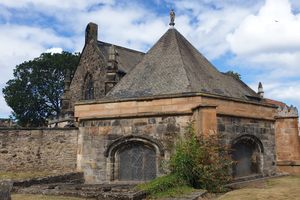About
The sheer scope and scale of this burial chamber are as impressive as its backstory. It's the final resting place of William Henry Miller, a person who was as mysterious as he was rich. Miller, being a Member of Parliament for Newcastle, spent little time in Edinburgh and was a bit reclusive, but he owned large tracts of land, including this marshy moorland around where this 30-foot mausoleum was constructed 8 years after his death.
It is partially due to his elusive behavior that rumors began to spread that this gentleman was, in fact, a gentlewoman. Because this was the 19th century, a woman could not own land. So, speculation began to form that an impersonation was incorporated to circumvent the law, and that the elaborate tomb was meant to help conceal his identity.
But there's another possible, more plausible explanation for the mausoleum's £20,000 (nearly $27,000 USD) worth of grandeur. As it was built during the time of the body snatching epidemic, when people acquired corpses by nefarious means for the burgeoning medical schools, it's plausible Miller had an apprehension toward becoming a victim to the Resurrection Men, or grave robbers as they were more commonly known. Therefore, it's believed he used his great wealth to construct a massive, 30-foot-deep protected resting place away from church burial grounds—common grave snatching places—to deter any would-be culprits. He also had his coffin lined with lead as an added deterrent.
Miller was a great admirer and collector of rare antique books, which might explain the ornate subject matter of the two marble panels designed by David Rhind, "The Overthrow of Pharaoh in the Red Sea",(South facing panel) and "The Song of Moses and Miriam", (North facing panel). The first relief was completed in 1861 and the later in 1863. It has been purported that his love of books was so great they he was seen carrying a ruler with him to calculate a tome's height before purchasing. This was so common that booksellers in London nicknamed him " Measure Miller"
At the time, visitors from all over the continent would come to marvel at friezes, noting that they were; ‘the most remarkable pieces of sculpture executed during this century’. Today, the locals commonly refer to this monument as the "Craigetinny Marbles", in homage to the Elgin Marbles held at the British Museum. In fact, the local Bowling Club, which is next door, has incorporated the mausoleum as their insignia.
There is a dedication plaque, which reads: "This monument was erected to the memory of William Henry Miller and his parents William Miller and Martha Rawson or Miller. Here are interred Martha Miller Died 11th January 1827; William Henry Miller MP for Newcastle-under-Lyme, born 13th February 1789, died 31st October 1848; Sarah Marsh Born 20th April 1792, Died 8th August 1860; Ellen Marsh Born 29th August 1801, died 4th November 1861. All of Craigentinny and Britwell Buckinghamshire. The site was consecrated on 13th September 1860. The sculptures were added in 1866. Architect David Rhind Edinburgh. Sculptor Alfred Gatley Rome."
Related Tags
Know Before You Go
The mausoleum is visible at anytime, though there is a barrier that prevents one from getting up close. The aforementioned Bowling Club has a parking lot and there is plenty of street parking in this residential neighborhood. Craigetinny Crescent is adjacent to the A1140/ road to Portobello, so there are several bus lines that service this route.
Flavors of Scotland: Beyond the Haggis
Smoked seafood, single malt whisky, and warm hospitality.
Book NowPublished
May 22, 2019
Sources
- https://www.boomedinburgh.com/memorial/
- https://www.edinburghnews.scotsman.com/whats-on/things-to-do/craigentinny-s-peculiar-roman-tomb-1-4277295
- http://craigentinnybc.co.uk/mausoleum/
- https://www.edinburghlive.co.uk/news/edinburgh-news/curious-tale-craigentinny-marbles-edinburgh-18218329
- https://www.edinburghlive.co.uk/news/edinburgh-news/curious-tale-craigentinny-marbles-edinburgh-18218329
- http://portal.historicenvironment.scot/designation/LB27191















































































